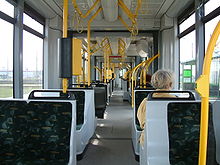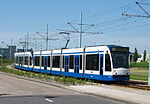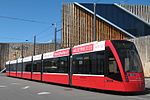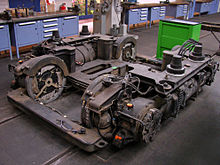Siemens Combino



The Combino is a low - floor tram series from the manufacturer Siemens . The prototype was built by Siemens-Duewag in 1996 . The successor model has been marketed under the name Avenio M since 2014 .
Due to its modular structure with standardized components and the resulting lower price, the Combino is considered a successful standard tram type. Around 500 vehicles of this type were sold in the cities of Amsterdam , Augsburg , Basel , Bern , Düsseldorf , Erfurt , Freiburg im Breisgau , Hiroshima , Melbourne , Nordhausen , Potsdam , Posen and Ulm . From 2004 onwards, a design error that led to breakdowns and material wear brought the Combinos into disrepute.
In 2007 the new Combino generation Combino Classic was sold to the city of Bern for the first time . The cars are now marketed by Siemens under the type designation Avenio M according to the multi-joint concept .
A further development as a short-articulated trolley made of stainless steel instead of aluminum, initially called Combino Plus , was sold in Budapest and Almada . Since 2009, this design has been given the new name Avenio .
concept
The Combino was developed by Siemens Düsseldorf (formerly Duewag AG ) in response to the constant price pressure on the market from 1994 onwards. The aim of the innovative concept was to switch from often tailor-made small series to a much more economical industrial large-scale production. The vehicle was designed as a modular system from standardized assemblies and should therefore cover as many possible uses as possible.
The Combino is available in different lengths, three carriage widths (2300, 2400, 2650 mm) and two track widths , as a one-way or two- way vehicle , and as a DuoCombino with an additional diesel drive. The vehicles made of aluminum are between 19 meters (Nordhausen) and 43 meters (Basel) in length. The "Combino Plus" NF12 for Budapest , supplied with steel car bodies , are even 54 meters long.
design
The design was based on the manufacturer's very tight targets. For example, all assemblies had to be optimized with regard to functional, economic and maintenance-related aspects. The design should support the company's goals, be concise and appeal to a large number of customers.
The design of the first Combino was developed by Werner Paulussen between 1994 and 1996 . The aim was a friendly and functional vehicle design with high recognition value and optimized ergonomic properties. This also included a glare-free destination display and good visibility for the rail vehicle driver. Maintenance and life cycle costs were other important factors in the design.
Paulussen supervised the project from 1994 to 2009 and, in addition to numerous studies, developed five different vehicle heads for the Combino series. The first series was used in Potsdam, Augsburg, Freiburg, Basel, Nordhausen and Erfurt. The second series for Amsterdam has been made more compact. Further vehicles of this series were delivered to Posen and Ulm. The designer Busse took on the color adjustment for the eight Ulm vehicles. The third series with very spacious driver's cabs runs in Erfurt , Nordhausen , Freiburg , Melbourne , Budapest and Bern with a modified front hood. A double target display was installed for Freiburg . The fourth series will be used in Almada (Portugal). In Bern, the new Combino for Bernmobil was presented in traditional aluminum construction with a vehicle head completely redesigned by Paulussen and a revised interior.
A plagiarism is in use in Dalian ( China ) . The trams there have an approximate Combino design. However, the drive of these cars differs significantly.
technology

The Combino is manufactured in lightweight construction in cooperation with the company Alusuisse . The screwed assemblies made of extruded aluminum profiles achieve an easily paintable surface. Thus straightening and filling work could be saved compared to conventional steel construction.
The Combino do not run on bogies , but on so-called bogies. The wheels are stored in chassis frames that cannot be swiveled out in relation to the associated car bodies. Longer, drive-free car parts ("sedan chairs") are hung between the drive modules with swivel joints and protected by bellows. The wheels are idler wheels without continuous axle shafts, they are driven side by side with longitudinal motors. The advantage of this design is the continuous low floor , which allows easy boarding and accessibility (for wheelchair users and prams) throughout the car.
This construction principle, however, results in uneven running properties, since the track guidance acts directly on the entire car body of the drive module even with small directional corrections on a straight line and not just on a bogie as in the conventional design. That means a two-axle vehicle with comparable running behavior and an increased wear of the wheel tires and the track , even on a straight stretch. In addition, there is no self-centering in the track due to the lack of axle shafts. This problem can be observed with many low-floor trams. However, the wear values depend on many parameters (rail material, substructure, track condition, driving style, flange lubrication , and much more), which is why very different values can be achieved with the same vehicle type depending on the location.
The modular construction of the Combinos is designed in such a way that the vehicles could theoretically be lengthened or shortened without great effort (as implemented in numerous Bernmobil vehicles). For example, all control elements required for a drive module are arranged directly above it, which in particular avoids complex cabling work. In many respects, the vehicles also offer advantages in terms of regular maintenance: For example, the engine and transmission units can be removed from the side without having to lift the vehicle. In the interior, all the seats in the long modules are attached to the side wall; the floor there is free of supports and can be easily cleaned, the seating arrangement can be adjusted by moving the seats on the mounting rail if necessary without major modifications.
Originally, the Combino concept also provided for single-axis end modules. However, this was only implemented on the four-part and five-axis prototype and was not pursued further.
Technical problems
In operation, weaknesses in the lightweight construction made of aluminum became apparent. The connections between the screwed aluminum frames came loose, and cracks appeared in the connections between the roof and the side wall on some of the cars. At the beginning of 2004, large parts of the Combino fleet were idle because Siemens could not rule out collapse of the vehicle roofs or progressive damage to the side walls. Siemens then had the customer, u. a. the Verkehrsbetrieb Potsdam GmbH, given the recommendation to discontinue the use Combinos from a mileage of 120,000 kilometers.
As a result of warranty claims from the Combino car, Siemens Transportation Systems posted an operating loss of 289 million euros in the second quarter of 2004; the special charges were put at a total of 364 million euros.
With the exception of a few badly damaged wagons, most of the Combinos are now back in service. One of the causes has now been recognized that the development engineers used calculation formulas for classic high-floor vehicles when calculating the car bodies. In doing so, they had forgotten that due to the multi-articulated construction of low-floor vehicles, the electrical equipment mainly housed on the roof and the lack of ability to roll the car parts against each other, considerable forces act on the overall structure. These were generally underestimated and their transmission and effect within the car bodies were incorrectly calculated. Any cracks that appeared endangered the stability of the construction.
According to press reports it is said that 450 of the Combino trams sold worldwide have to be almost completely rebuilt. Siemens denies this, but the group has now set up around 500 million euros in provisions for these risks. Siemens is working on refurbishing the cars; the first fully refurbished units were deployed in Amsterdam (here the hundredth of 155 trains to be refurbished was delivered in August 2007), Potsdam, Erfurt, Freiburg, Nordhausen and Posen. As the first Combino fleet of an operator, that of the city of Bern has been completely renovated since the beginning of 2007. In November 2009 the last revised Combino was put back into service in Düsseldorf. On December 19, 2009, the Basler Verkehrs-Betriebe received their last Combino back. This enabled the last unit to be refurbished in Europe to be put back into operation and the upgrading of all Combinos to be completed. The renovated vehicles are characterized by improved load distribution, the ability to roll the car bodies with one another and, as a result, significantly better driving characteristics.
Locations
Overview
| city | operator | model | Construction year | number | image |
|---|---|---|---|---|---|
| Almada | Sul do Tejo Metro (MST) | Combino Plus | 2005-2007 | 24 |

|
| Amsterdam | Tram Amsterdam (GVB) | Advanced | 2002-2004 | 155 |

|
| augsburg | Augsburg Transport Company (AVG) | NF8 | 2000 + 2002 | 41 |

|
| Basel | Basler Verkehrs-Betriebe (BVB) | Be 6/8 | 2001/2002 | 28 |

|
| Bern | Bernmobil (Municipal Transport Company Bern) |
Be 4/6 Advanced Be 6/8 Advanced Classic |
2002–2004 2002 + 2004 1 2009/2010 |
7 8 21 |

|
| Budapest | Budapesti Közlekedési Zártkörűen Működő Részvénytársaság (BKV) | Combino Plus | 2004-2006 | 40 |

|
| Dusseldorf | Rheinbahn AG | NF10 NF8 NF8U NF8U |
2000–2002 2003 2006/2007 2010–2012 |
36 15 15 61 |

|
| Erfurt | Erfurt Transport Authority (SWE EVAG) | Basic (5) Advanced (5) Advanced (3) Classic (3) |
2000 2002/2003/2005 2002/2004/2005 2011/2012 |
7 29 12 12 |

|
| Freiburg in Breisgau | Freiburger Verkehrs AG (VAG) | Basic Advanced |
1999/2000 2004/2006 |
8 2 10 |

|
| Hiroshima | Hiroshima Dentetsu | 1999-2002 | 12 |

|
|
| Kaohsiung | 0 3 | ||||
| Melbourne | Yarra trams | Advanced (3)
Advanced (5) |
2002/2003
2003/2004 |
38
21st |

|
| Nordhausen | Stadtwerke Nordhausen | Basic (3) Advanced (3) Combino Duo |
2000 2002/2011 2004 |
2 7 3 |

|
| Poses | Tram Poznan | 2004 | 14th |

|
|
| Potsdam | Potsdam Transport Authority (ViP) | Basic (4) Basic (5) Basic + Avenio M (7) Basic + Avenio M (7) |
1996 1998–1999 2000/2017 2001/2018 |
1 4 8 4 4 |

|
| Ulm | Stadtwerke Ulm / Neu-Ulm (SWU) | Advanced Avenio M |
2003 and 2008 2017 |
10 12 5 ; 6th |

|
Potsdam
In 1997, the city of Potsdam's public transport company was the first municipality in the world to acquire Siemens Combino. At the introduction, the accessibility of the new cars was emphasized. A total of 48 vehicles should be purchased by 2009 - four vehicles per year. The order from Potsdam played a major role in PR campaigns in other cities in the first few years. If new acquisitions were planned, vehicles from Potsdam were shown there for demonstration purposes. However, due to financing problems on the part of the city, only 16 vehicles were delivered. The appointment was postponed from 2002 to 2004.
Due to the Combino crisis (recall of all Combino vehicles for refurbishment), the order for the 32 remaining vehicles was canceled. The existing Combino fleet was completely renovated by December 2008. The last thing to do was to renovate the Combino prototype with car number 400 by Siemens so that it could then be used for passenger operations.
In October 2008, the transport company ordered 18 Variobahns from Stadler . An appeal by Siemens against the award of this contract to the competitor was rejected in March 2009.
Since July 2017, vehicles 409 to 416 (eight units) have been equipped with two additional middle sections. As a result, the vehicle is lengthened by 11.1 to approx. 41.7 meters with an increase in mass of 10 tons. The available space increases by 11 seats and 62 standing places to 77 seats and 169 standing places.
The first test drive of the new "Combino XL" took place on September 20, 2017 in Potsdam.
Budapest
For Budapest , Siemens developed the Combino Plus , an articulated tram that is very similar in design to the previous Combino constructions, but differs in some fundamental points. On the one hand, the car bodies are now made of stainless steel instead of aluminum, and on the other hand there are no drive-less modules. Until the delivery of the CAF Urbos 3/9 to Budapest in 2016, the units were 54 meters long and were the longest trams in the world. They consist of six elements, each with a carriage, which are connected with two different types of joint. Two of the five joints allow the car bodies to be offset transversely; in terms of running technology, a Combino Plus therefore corresponds to three short- articulated carriages that are closely coupled to one another . The first vehicle was delivered in March 2006. The names Combino Supra or Combino NF12B are the names of the BKV . The start of operations in Budapest led to further challenges in Combino vehicle development. The responsible authorities even spoke of returning the car. On May 4, 2007, the 40th and last train from the Siemens plant in Vienna was delivered to the operator BKV Rt. All vehicles are used on lines 4 and 6.
Combino Duo in Nordhausen
In the Nordhausen tramway , a variant called Combino duo with two-power drive is used on a partially non-electrified route . On the non-electrified HSB route between Nordhausen Nord and Ilfeld, the vehicles are powered by an eight-cylinder BMW diesel-electric car engine. Like the other vehicles of the Nordhausen tram, these cars are only three-part and therefore quite short, which earned them the nickname "Bambino".
Trivia
In November 2001 the city of Basel advertised a Combino in Berlin . Since the railways of the two cities have different gauges, a Potsdam vehicle was borrowed , which was optically transformed into a tram for the Basler Verkehrs-Betriebe . For the demonstration in Leipzig in late autumn 2002, however, Siemens used the Erfurt railcar 632, which was originally equipped with regular-gauge bogies for Amsterdam.
Comparable designs from other manufacturers
literature
- Combino - the modular low-floor tram . In: Eisenbahn-Revue International , issue 6/2002, ISSN 1421-2811 , pp. 293–295.
- The Combino Tram - from successful sales to problematic . In: Eisenbahn-Revue International , issue 5/2004, ISSN 1421-2811 , p. 200.
- Martin Pabst: Tram vehicles. Volume 2: Type book of low-floor and light rail vehicles. GeraMond Munich 2000. ISBN 3-932785-17-7 . Pages 130f (Potsdam), 146 (Augsburg), 147 (overview) and 148f (Düsseldorf).
Individual evidence
- ↑ Avenio - on the move as a tram and light rail. Siemens AG, accessed on June 16, 2020 .
- ↑ Avenio - fits your city. Our 100% low-floor trams, made especially for you. on the Siemens website
- ↑ PLAGIARIUS design award for the plagiarism of the Combino tram
- ↑ a b c Follow-up costs of the tram debacle still unclear: "Combinos" are becoming a brake on Siemens. ( Page no longer available , search in web archives ) Info: The link was automatically marked as defective. Please check the link according to the instructions and then remove this notice. Rheinische Post from May 18, 2004
- ↑ a b Tram debacle: Siemens has to make improvements. Focus from May 18, 2004
- ↑ Debacle for Siemens: The tram that threatens to collapse. Süddeutsche Zeitung of May 18, 2004
- ↑ Combino remains a problem. Potsdam Latest News from January 8, 2005
- ↑ Message Siemens senses Combino problem . In: Eisenbahn-Revue International , issue 7/2004, ISSN 1421-2811 , p. 324.
- ↑ Düsseldorf's Silver Arrows - the most expensive repairs of all time . NRZ from November 28, 2009
- ↑ http://www.tram-info.de/wagenp/freiburg.htm
- ↑ Ulm: New vehicles come from Siemens. In: www.tramreport.de, July 19, 2014
- ^ The longest trams in the world are put into service on tram line 1. Budapesti Közlekedési Központ Zrt., March 31, 2016, accessed on September 24, 2016 (Hungarian).
Web links
- Product description of the Avenio M and Avenio at Siemens
- Combino on the homepage of Guido Studer, Basel
- The Potsdam Combino - development, commitment and prospects
- Detailed description of the Combinos, Advanced and Basic from FVAG Freiburg ( Memento from June 12, 2010 in the Internet Archive )
- Press release on the purchase of the Combino Classic by Bernmobil
- Interactive 360 ° tour through a Combino Plus train






